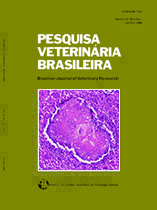 |
|
|
|
Year 2017 - Volume 37, Number 11
|

|
Antimicrobial susceptibility patterns of Brazilian Haemophilus parasuis field isolates, 37(11):1187-1192
|
ABSTRACT.- Miani M., Lorenson M.S., Guizzo J.A., Espíndola J.P., Rodríguez-Ferri E.F., Gutiérrez-Martín C.B., Kreutz L.C. & Frandoloso R. 2017. Antimicrobial susceptibility patterns of Brazilian Haemophilus parasuis field isolates. Pesquisa Veterinária Brasileira 37(11):1187-1192. Laboratório de Microbiologia e Imunologia Avançada, Universidade de Passo Fundo, Campus I, Edifício G3, Bairro São José, Passo Fundo, RS 99052-900, Brazil. E-mail: rfran@upf.br
Haemophilus parasuis is the etiological agent of Glässer’s disease (GD), an ubiquitous infection of swine characterized by systemic fibrinous polyserositis, polyarthritis and meningitis. Intensive use of antimicrobial agents in swine husbandries during the last years triggered the development of antibiotic resistances in bacterial pathogens. Thus, regular susceptibility testing is crucial to ensure efficacy of different antimicrobial agents to this porcine pathogen. In this study, 50 clinical isolates from South Brazilian pig herds were characterized and analyzed for their susceptibility to commonly used antibiotic. The identification and typing of clinical isolates was carried out by a modified indirect hemagglutination assay combined with a multiplex PCR. The susceptibility of each isolate was analyzed by broth microdilution method against a panel of 21 antimicrobial compounds. We found that field isolates are highly resistance to gentamycin, bacitracin, lincomycin and tiamulin, but sensitive to ampicillin, clindamycin, neomycin, penicillin, danofloxacin and enrofloxacin. Furthermore, an individual susceptibility analysis indicated that enrofloxacin is effective to treat clinical isolates with the exception of those classified as serovar 1. The results presented here firstly demonstrate the susceptibility of Brazilian clinical isolates of H. parasuis to antimicrobials widely used by swine veterinary practitioners and strengthen the need to perform susceptibility test prior to antibiotic therapy during GD outbreaks. In addition, because only six antimicrobial drugs (28.6%) were found effective against field isolates, a continuous surveillance of the susceptibility profile should be of major concern to the swine industry. |
| |
|
|
| |
|
 |